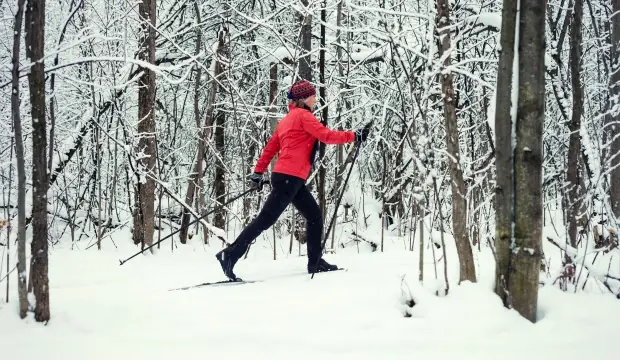ALPINE | EXTREME | NORDIC

Cross Country—Unlike alpine skiing where you head downhill, cross-country skiing is performed on relatively flat terrain, often in the countryside rather than on a mountain. Often said to be one of the most difficult sports in terms of endurance, this sport is the ideal way to get a stellar workout while still being out in nature. Plus, you usually don't have to travel very far or pay the pricey resort lift tickets, which can be upwards of $100.
The largest cross-country ski race includes the 50-plus-kilometer American Birkebeiner race—"The Birkie"—held in northern Wisconsin each year. This year's race is held from February 20th to the 23rd, and is slated to attract more than 10,000 participants. Birkie.com
Type of ski: Cross-Country skiing uses specific cross-country skis that are long and thin and have a binding with a free heel. Cross-country skiers also use poles to push themselves forward.
Telemarking—Telemarking is basically a mix between cross-country skiing and alpine skiing—you do ski downhill, but your heels are not affixed. In action, telemark skiers appear to almost be in a full lunge while turning.
Type of ski: Telemark-specific skis are often more flexible than regular skis and have bindings where boots do not attach at the heels.
Alpine Touring or Randonee—Alpine touring (AT) has boomed in the past few years, with many resorts offering free runs for those who choose to skin up, rather than take the chair, though often Alpine Touring is done in the backcountry. Although still exhausting, skinning uphill is easier than hiking in deep snow.
The gear for AT differs from regular alpine skiing gear because the heel can be unattached for going uphill and fixed for descending. You'll also need the actual skins—strips of synthetic fur on one side, and a very strong, reusable adhesive on the other. You stick on the adhesive side to the underside of your skis, and then the fur side helps you move uphill without sliding back down. Once you're ready to descend, simply strip off the skins and stick them in your pack.
Type of ski: Alpine Touring skis, boots and skins. AT skis are lighter weight than alpine skis but can still can still handle powder.
Hut-to-hut—If you're looking for an adventure that's more than a hike but not as cold as winter camping, try booking a hut-to-hut trip. For these journeys, you often hike or skin up to a hut with a loaded pack, and then over or back down, depending on your track. Because there are numerous huts and tracks to take, the type of ski depends on what path you'll be taking. Will you be ascending to the hut? Traversing to the next one? Skiing down right after?
Type of ski: For a trek that's mostly flat, opt for cross-country skis to push you along. If you'll be hiking up and then skiing down, an Alpine Touring setup will be your best option.
Related Articles:
 Book your next camping trip
Book your next camping trip



